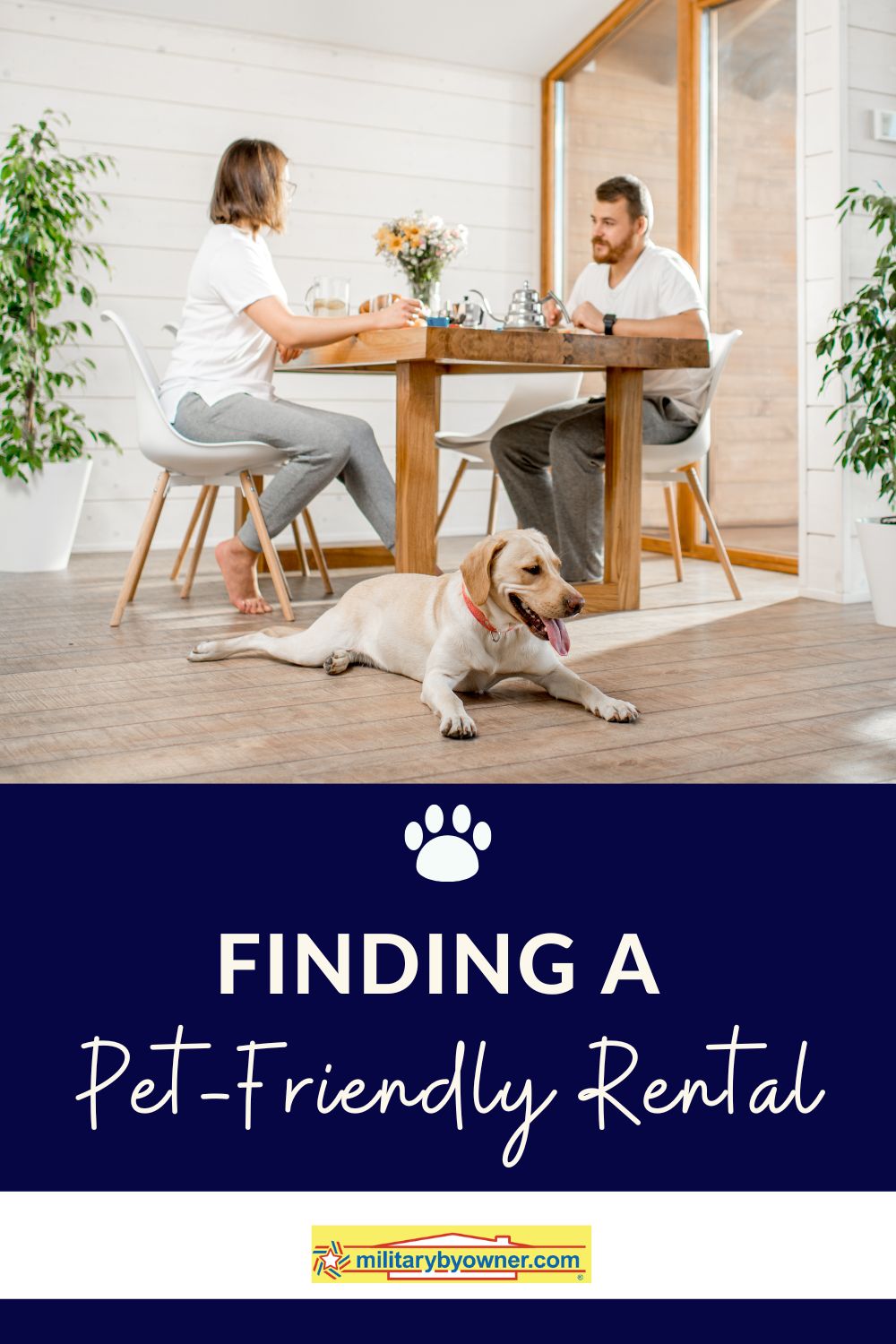
Photo from Canva
In this article:
There’s a popular club that more than half of rental home tenants belong to. It's called Renters with Pets. The key membership detail is pet ownership and the consistent plight of finding a welcoming rental home with a pet, or two, or three, in tow. For prospective renters, the two words “pet friendly” in a rental property description are welcomed, but often misleading.
Pet owners search diligently for animal friendly housing, but regularly run into restrictions against breed, size, weight, and bans on what are considered domestic animals. In some circumstances, home renters and animals are turned away even though they are registered service or emotional support animals.
The Humane Society reports that 72% of renters are pet owners, with dogs and cats leading the pack. But birds, fish, reptiles, and small furry creatures like rabbits and chinchillas also have families that love them and consider their precious pet part of the family.
What can military families do to prepare to find a rental house with pets?
How to Search for a Pet-Friendly Rental Home
It's likely going to require multiple rounds of searching for a rental home that accepts pets, especially if you have an unusual animal. You may need to consider altering the other amenities you’ve prioritized. Changing the location, square footage requirement, or price point might yield more pet-friendly homes.
Think Outside of the Home Rental Listing Box
Of course, you’ll search MilitaryByOwner to find pet-friendly listings.
But if you're having issues finding a home with your particular breed of dog, search outside-of-the-box websites like Mypitbullisfamily.org. This non-profit organization created a pet-friendly rental home company database with “a mission to keep families together by advancing dog-inclusive rental and insurance policies and providing essential pet retention programming.” These rental homes include properties that avoid breed or weight restrictions and allow dogs with a Canine Good Citizen certification or that pass a pet interview.
Leverage Your Personal Resources
One of your best resources for finding a pet-friendly rental home is to tap into your personal resources, like social media and online and in-person groups. Maybe you’ve joined a local chapter of a dog meet-up group? Talk to the members about their rental home successes.

Photo from Canva
Prepare a Pet Resume
No, you don’t have to write out each job your dog performs at home, but a summary of your pet’s health, training, and even a few lines of recommendation from past landlords could put a future landlord at ease. If you’ve put enough time and care into assembling a profile of your pet, a property manager should see how invested you are into caring for the pet inside the home.
Items to include:
- A picture of your animal at their cutest and on their best behavior.
- Veterinarian records documenting up to date vaccines and flea and tick preventives.
- Letters of recommendation from previous landlords mentioning how well kept the home was, without damage or smell.
- Notes from professional groomers who have worked with your animal without incident.
- Receipt from a pet insurance policy.
- Certification from any professional training: therapy, obedience, agility.
- An offer for the homeowner or property manager to interview the animal and see first hand their temperament and training.
Include any other information that would help your case, such as information on the high tech, indestructible tank or cage the animal lives in and the safety mechanism of the closing feature.
back to top

Photo from Canva
Types of Rental Pet Policies
The best scenario during a search on MilitaryByOwner is checking the filter box that’s labeled “Pet Friendly.” With this designation, you know there’s a least a chance your pet will be accepted. The truth is, “pet friendly” or “pets allowed” normally equates to dogs, cats, and small caged animals. Owners do not list animals that are not accepted, including certain dog breeds and exotic animals. It's up to you to inquire if your bearded dragon or hamster family is welcome.
The same is true for the amount of animals allowed in the home. Pet friendly likely means one dog is fine, but four dogs and three cats may not be welcomed.
Do not try to hide your animal. The lease agreement you’ll sign typically has wording stating an owner or manager has the right to inspect the property, whether notice is given a week or an hour prior. You could face eviction or fees if an animal is living in the house illegally. This includes a fish aquarium. While there is a debate about if a fish can be a pet, there’s no debate that a leaky aquarium is equal to expensive water damage and a huge scare for property owners.
Here are some lease terms you may find when looking for a rental that allows pets.

Photo from Canva
Pets Accepted on Case-by-Case Basis
A gray area in pet acceptance policy is the “case-by-case” basis. This catch-all is a term owners use to filter out animals who they feel will cause damage. This wavering scenario is a perfect time to hand over your pet’s resume. If the owner has concerns, you’ll have documentation to provide reassurance.
If the homeowner still seems unconvinced, an offer of a larger pet deposit, or a monthly pest control service may do the trick, especially if the rental property has been sitting empty for a while.
No Pets Allowed
Keep in mind, property owners who advertise a strict No Pets policy usually have bad experiences in their past, either from their own interactions or with tenants who weren’t responsible pet owners. The likelihood the that landlord changes their mind and accepts pets isn’t great. Stick with pet-friendly and case-by-case basis advertisements.
Common Breed Restrictions
Dog owners who own commonly restricted breeds often find their rental search constrained by the dog’s breed. It's a difficult search, and can be compounded by local government breed restrictions in addition to a property management company’s insurance policies.
These are the breeds typically rejected, but others are included, depending on the property:
- American Pit Bull
- Stafford Bull Terrier
- Bull Mastiff
- Doberman Pinscher
- Rhodesian Ridgeback
- Chow Chow
- Wolf Breeds
- Mixed breeds with these dominant characteristics.
Understand that military housing companies have their own Dog Breed Restrictions for On-Base Military Housing.
Renters with dog breeds that are commonly banned generally find better results with private homeowners, especially those sympathetic dog owners who have owned a banned breed in the past. They may have actually purchased a house because rental homes were regularly unavailable. They understand your dog probably is a softie, and that banned breeds sometimes get a bad rap.
back to top

Photo from Canva
Rental Lease Agreement Terms with Pets
In preparation for renting with pets, carefully review the lease presented and insert amendments that were orally discussed. You’ll want to specifically check how, and when, your pet deposit is returned, and IF the deposit is returned. Some owners require a one-time payment, others ask for what is called pet rent.
The American Kennel Club says this about pet rent:
“With pet rent you’ll pay a monthly fee as long as you and your pet live in the rental. The fee is relatively small — usually $35 or less — and is considered a discretionary charge, meaning the landlord can legally include this extra charge in your lease, in most cases.”
More details in the lease to note:
- How many pet deposits? One per animal, or one in total?
- If the owner earns interest on the pet deposit money, who receives the interest money?
- How is money deducted from the pet deposit? And for what kind of damages?
Renting a Home on Base with a Pet
.png)
Photo from Canva
One of the primary ways military families find pet-friendly rentals is to move on base. This is to say, base housing is pet friendly within the parameters that most pet-friendly homes off base are accepting of pets: minimal numbers, restricted breeds, and clear guidelines for what domestic animals include. You won’t be able to move on base with a monkey, donkey, or barnyard animals.
When living on base, not only are pet owners bound by the installation’s pet policies, but the private housing company’s rules for pets in the home. These vary from base to base, and company to company, but again, the general guidelines are similar.
If you’d like more information, see Which Pets Aren't Allowed in Military Housing?
Keep in mind that military housing tends to be close in proximity and a chief complaint about living on base is against those who don’t abide by the established pet rules, especially leash laws and what constitutes an “outdoor” dog or cat, their ability to roam, and adequate shelter outdoors.
back to top
Renting a Home with a Service Animal

Photo from Canva
Military families are a group who, because of the servicemember’s dangerous line of work, unfortunately have the proclivity to require the assistance of a service or support animal.
Although legitimate service and support animals are protected under the Fair Housing Act, property owners are often confused or ignorant as to what the act entails. Under the law, service animals are “reasonable accommodations” and even rental properties that have a “no pet policy'' must allow a tenant and service animal access to the home. Here is what the U.S. Department of Housing and Urban Development says about service and support animals:
“The Fair Housing Act makes it unlawful for a housing provider to refuse to make a reasonable accommodation someone with a disability may need to have equal opportunity to enjoy and use a dwelling. One common request housing providers receive is for a reasonable accommodation related to a provider’s no-pet or no-animal policies from people with disabilities so they may use assistance animals in their housing, including in public and common-use areas. Assistance animals are not pets; they are either service or support animals. A housing provider may not exclude service animals or support animals or charge a fee or deposit for them.”
More details about what types of animals are deemed service or support animals include:
“For an animal to be eligible for consideration as a support animal, it must be one that is commonly kept in homes, such as a dog, cat, small bird, rabbit, hamster, gerbil, other rodent, fish, turtle, or other small, domesticated animal.”
There are some exclusions to this law and they involve who owns the property and the size of the property. States also have laws regarding service animals and housing, so be sure to check your state's specific guidelines. From the Americans with Disabilities Act:
"Many states also have laws that provide a different definition of service animal. You should check your state’s law and follow the law that offers the most protection for service animals... While Emotional Support Animals or Comfort Animals are often used as part of a medical treatment plan as therapy animals, they are not considered service animals under the ADA. These support animals provide companionship, relieve loneliness, and sometimes help with depression, anxiety, and certain phobias, but do not have special training to perform tasks that assist people with disabilities. Even though some states have laws defining therapy animals, these animals are not limited to working with people with disabilities and therefore are not covered by federal laws protecting the use of service animals. Therapy animals provide people with therapeutic contact, usually in a clinical setting, to improve their physical, social, emotional, and/or cognitive functioning."
and
The Fair Housing Act (FHA) protects a person with a disability from discrimination in obtaining housing. Under this law, a landlord or homeowner’s association must provide reasonable accommodation to people with disabilities so that they have an equal opportunity to enjoy and use a dwelling. Emotional support animals that do not qualify as service animals under the ADA may nevertheless qualify as reasonable accommodations under the FHA. In cases when a person with a disability uses a service animal or an emotional support animal, a reasonable accommodation may include waiving a no-pet rule or a pet deposit. This animal is not considered a pet.
Finding a pet-friendly rental home is not impossible, but the search often requires multiple tries to find the right fit, so leave plenty of time before a pending PCS. As the pet owner, the burden is on you to demonstrate how seriously you take the responsibility of owning an animal, which normally means coughing up extra money for deposits and pet rent.
And because pet-friendly rentals are in short supply, you may have to choose out-of-the box techniques to demonstrate to potential landlords your beloved pet is quiet, clean, and well-behaved. Polish your pet resume early!
By Dawn M. Smith


back to top